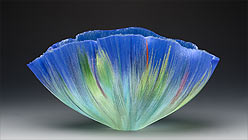This summer, with little fanfare, the Cantor Arts Center at Stanford University borrowed fewer than 20 rather superb works of Contemporary Glass from local collections and put on a show. The reason for this modest endeavor was not to respond to the gargantuan scale of Chihuly at the de Young. Rather, it was to call attention to the connection between Stanford University and the Venetian glass firm of Salviati & Co., whose mosaic murals grace Stanford Memorial Church. Jane Stanford herself gave the Salviati company the commission, for which the Salviati company gave Mrs. Stanford some 200 glass vessels as a thank-you gift.
As conceits go, this one’s predictably precious, but Stanford is not the only august institution of higher learning to be somewhat taken with itself, so it’s in good company. More interesting than the self-congratulatory reason for the show is the art and, like it or not, how this exhibition compares to the three-ring circus to the north.
The pieces in Contemporary Glass are displayed in the circular Oshman Family Rotunda (the balcony overlooking the Rodin sculptures) and the long H. L. Kwee Galleria (the second-floor passageway adjacent to the main galleries of contemporary art). The show begins at the nexus of both spaces with a hand-painted, lampworked piece from 1995 by Ginny Ruffner. Like many of Ruffner’s sculptures, this one, called Double Dutch, is built on an open armature of glass, which, in this case, resembles a six-sided diamond pointing up. Attached wherever it seems convenient and aesthetically sensible is a heart, fish hook, picture frame, flower, and pair of frontward and backward capital Ds, whose voids have been filled in with almost naive copies of the couple in the famous Jan van Eyck painting from 1434 called The Arnolfi Portrait. Never mind that van Eyck was not Dutch; Ruffner is more interested in poetry than precision. The surface of Ruffner’s work is the thing that continues to get me. I just love the way her colors alternately hide or accentuate the sand-pitted surface of her fragile, occasionally unwieldy, forms.
Just down the hall is a lovely piece by Richard Royal, who spent a couple of decades (or maybe it just felt like that) as a gaffer on various Chihuly teams. Part of the Relationship Series, this 1992 work consists of a pair of bowls, one a soft blue, the other an equally quiet green, whose bases, if you can imagine this, are shaped like snaking tails or tendrils. The tails face each other so that one bowl rests on its rim while the other is open at the top. In the middle, simultaneously being caressed by and holding these two mirror images together, is a traditionally shaped purple vase, suspended in space by the embrace of the green and blue tendrils. Like much of Royal’s work, this deceptively simple piece does not call undue attention to itself. Certainly there are countless more fantastic examples of these sorts of snaking shapes, in a shamelessly varied range of colors, up at the de Young, but Royal is not going for volume here. For him, it’s quite enough, thank you, to do one thing with modest perfection.
Toward the end of the hall is one of two works in the show by Richard Marquis. This one is a teapot from 1977, which was selected, no doubt, because of Marquis’s use of murrine, which are slender threads of glass that have been collected and then fused to reveal patterns or designs when they are cut into cross sections (picture sushi, with white glass for the rice, purple glass for the tuna, green for the cucumber, etc.) Marquis’s murrine designs lean to hearts, stars, and checkerboards, which he applies to his vessels when they are still hot. As the vessel expands and is deliberately distorted, the murrine become blurry and irregularly shaped, all of which gives the teapot the look of something you might find in the kitchen cupboard of one of the Freak Brothers.


